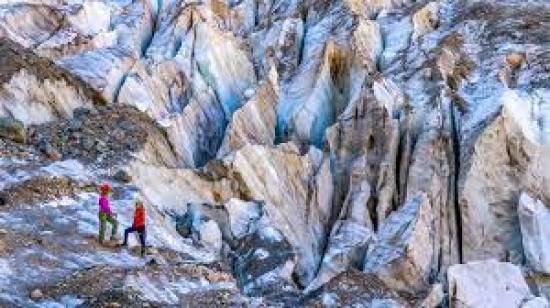Glaciers on Türkiye’s mountains melting due to global warming, says expert
The expert pointed out that there has been a significant melting of the ice on the summit of Mt. Ağrı, which has the largest glacier cover in Türkiye stretching from the south to Öküz (Ox) Stream in the province of Ağrı’s Doğubayazıt district and from the north to the Cehennem (Hell) Valley in the province of Iğdır’s Aralık district.
“As someone who has climbed the mountain more than 20 times in the last 36 years, I can easily recognize it,” said Güngör, who has set on reconnaissance expeditions on glacial mountains. “The melting of ice in the valley can be seen even at 4,400 meters [14,435 ft].”
“Those who climb Mt. Ağrı, which has a glacier on its summit, especially in summer, should definitely pay attention to whether the glacial cracks are widening,” he urged.
Small amounts of glacier milk, which is water coming from glaciers containing rock particles giving it a cloudy appearance, in Öküz Stream have been seen frequently for years, while landslides caused by melting glaciers are experienced in Cehennem Stream every few years, Güngör said, underlining that all these events are signs of the rapid meltdown of the glaciers on Mt. Ağrı.
“In 1985, when I first started mountaineering, there were large glacier masses in Mt. Erciyes [in the Central Anatolian province of Kayseri]. Now they have almost disappeared,” Güngör said.
“Mt. Süphan [in the eastern province of Bitlis], on the other hand, has no glacier left but a piece of a glacier at the summit. Massive glacier meltdowns are also observed in the central and eastern Taurus Mountains [in the eastern Mediterranean] and Kaçkar Mountains [in the Black Sea region],” the expert said, adding that the impact of global warming on these meltdowns is huge.
Kapuzbaşı Waterfalls, in Kayseri’s Yahyalı district, whose main source is the glaciers on the Yedigöller plateau, will dry up in a short time if the melting of these glaciers continues at this rate, according to Güngör.
“The glacier on Mount Cilo [in the southeastern province of Hakkari] continues to melt rapidly, but there is no clear information about the extent of the melting yet,” Güngör added.
The expert noted that the probability of an avalanche disaster, as in Italy, is very low, but such a risk can be encountered in glacier climbing on the northern sides of the mountains, for instance, in Kaçkar and Cilo.
It is not possible to reverse this situation, according to Güngör. “Because we have experienced glacial meltdowns that would take place in a thousand years in the last 50 years.”
“Future projects should regard how we can adapt to changing conditions,” he added./agencies


